Click on images to enlarge
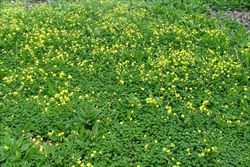
large infestation (Photo: Sheldon Navie)

dense infestation (Photo: Sheldon Navie)

habit (Photo: Sheldon Navie)
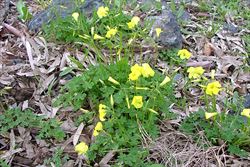
habit (Photo: Sheldon Navie)
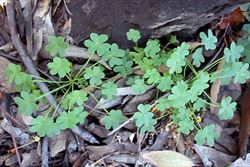
habit prior to flowering (Photo: Sheldon Navie)
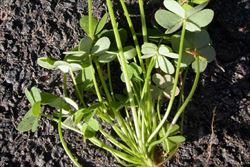
stems and leaves (Photo: Greg Jordan)

close-up of leaf with three heart-shaped leaflets (Photo: Greg Jordan)
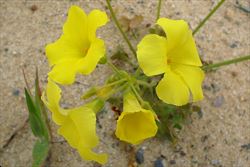
flowers (Photo: Sheldon Navie)
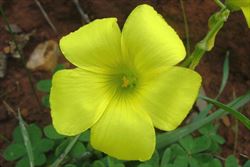
close-up of flower (Photo: Sheldon Navie)

close-up of flower from side-on (Photo: Greg Jordan)

white fleshy rhizomes with bulbils forming on them (Photo: Sheldon Navie)

young plant (Photo: Sheldon Navie)
Scientific Name
Oxalis pes-caprae L.
Synonyms
Oxalis cernua Thunb.
Family
Oxalidaceae
Common Names
African wood sorrel, African wood-sorrel, African woodsorrel, Bermuda buttercup, buttercup oxalis, Cape cow-slip, Cape cowslip, Cape sorrel, drooping wood sorrel, Englishweed, large yellow soursob, oxalis, shamrock, sorrel, sour grass, sour sob, sourgrass, soursob, soursobs, soursop, soursops, South African wood sorrel, variable wood sorrel, variable wood-sorrel, wild sorrel, wood sorrel, yellow flowered oxalis, yellow sorrel, yellow sour-grass, yellow-flowered oxalis
Origin
Native to southern Africa (i.e. South Africa and Namibia).
Cultivation
Soursob (Oxalis pes-caprae) was originally introduced into Australia as a garden ornamental. It is no longer deliberately cultivated, but is often seen as a weed of gardens.
Naturalised Distribution
Widely naturalised, particularly in the southern parts of Australia. It is common in eastern and southern New South Wales, Victoria, Tasmania, south-eastern South Australia and south-western Western Australia. Also occasionally naturalised in south-eastern Queensland and the southern parts of the Northern Territory, as well as in other parts of New South Wales, South Australia and Western Australia.
Naturalised overseas in Europe, tropical Asia, New Zealand and southern USA (i.e. California, Arizona and Florida).
Habitat
This species is most commonly found in temperate regions, but occasionally also inhabits semi-arid and cooler sub-tropical environments. It is a weed of gardens, parks, lawns, waterways, roadsides, disturbed sites, waste areas, pastures, grasslands, open woodlands, crops and orchards.
Habit
A long-lived (i.e. perennial) herbaceous plant with upright (i.e. erect) flowering stems usually growing 15-30 cm tall, but occasionally reaching up to 45 cm in height. It produces a rosette of leaves at ground level and underground stems (i.e. rhizomes), bulbs, bulbils and tubers. The aboveground stems and leaves are short-lived (i.e. annual) and die back each year.
Distinguishing Features
- a long-lived herbaceous plant growing each year from underground bulbs.
- it produces a rosette of leaves at ground level and leafless upright flowering stems 15-30 cm tall.
- its leaves are borne on stalks 10-22 cm long and have three heart-shaped leaflets.
- its bright yellow flowers have five petals and are borne in loose clusters.
- these flowers open only during sunny periods and close again at night or during dull conditions.
Stems and Leaves
The slender flowering stems are sparsely hairy (i.e. pubescent), leafless, and round in cross-section.
The leaves emerge from the top of an underground stem (i.e. rhizome) at or just below the soil surface. They are borne on long stalks (i.e. petioles) 5-22 cm long and consist of three heart-shaped (i.e. obcordate) leaflets. These leaflets (5-30 mm long and 4-35 mm wide) are mostly green in colour, sometimes bearing brown or purple-coloured markings, and fold downwards during darkness. They are hairless with entire margins and deeply-notched tips (i.e. emarginate apices).
Flowers and Fruit
The bright yellow flowers (25-40 mm across) are borne in loose clusters (each with 3-25 flowers) at the top of the stems on individual stalks (i.e. pedicels) up to 20 mm long. They are trumpet-shaped (i.e. tubular) in appearance with five broad overlapping petals (15-25 mm long) that are fused together towards their bases. These flowers also have five sepals, ten stamens and an ovary topped with five styles. They open only during sunny conditions and close again at night or during dull conditions. Flowering occurs mainly from early winter through to late spring (i.e. from May to November).
The short capsules are rarely formed in Australia.
Reproduction and Dispersal
This species most commonly reproduces via underground bulbs and bulbils (seeds are rarely produced in Australia). The cone-shaped (i.e. conical) bulbs are white, fleshy segments (8-30 mm long) covered in brown scales, while the bulbils are smaller and generally lack the brown covering of scales.
Bulbs and bulbils are most commonly spread by cultivation and other forms of soil movement. They are also dispersed to new areas in contaminated soil, in dumped garden waste, by water movement and by animals (e.g. birds).
Environmental Impact
Soursob (Oxalis pes-caprae) is a significant environmental weed in Victoria and South Australia and an environmental weed in Western Australia and New South Wales.
Legislation
This species is declared under legislation in the following states and territories:
- New South Wales: Class 5 - a restricted weed which must not be sold, bought or knowingly distributed (throughout the entire state).
- South Australia: 3* - declared in Class 3, a designation for agricultural weeds. This species is required to be controlled in part of the state only.
- Victoria: C2 - all reasonable steps must be taken to control this species and prevent its spread (in the Glenelg and Corangamite regions).
- Western Australia: Prohibited - on the prohibited species list and not permitted entry into the state.
Management
For information on the management of this species see the following resources:
- the Environmental Weeds Action Network (EWAN) brochure on oxalis species, which is available online at http://members.iinet.net.au/~ewan/pdf/oxalis.pdf.
- the Tamar Valley Weed Strategy website page on oxalis species at http://www.weeds.asn.au.
Similar Species
Soursob (Oxalis pes-caprae) is very similar to Oxalis compressa and relatively similar to creeping oxalis (Oxalis corniculata) and pink bulb soursob (Oxalis flava). These species can be distinguished by the following differences:
- soursob (Oxalis pes-caprae) does not have creeping aboveground stems and reproduces mostly via underground bulbs. Its relatively large yellow flowers (up to 40 mm across) are borne in loose clusters on a long upright (i.e. erect) stalk. Its leaves are borne on long cylindrical stalks (i.e. petioles) and have three heart-shaped (i.e. obcordate) leaflets.
- Oxalis compressa does not have creeping aboveground stems and reproduces mostly via underground bulbs. Its relatively large yellow flowers (up to 40 mm across) are borne in loose clusters on a long upright (i.e. erect) stalk. Its leaves are borne on long stalks (i.e. petioles) that are flattened or slightly winged and have three heart-shaped (i.e. obcordate) leaflets.
- creeping oxalis (Oxalis corniculata) has creeping above-ground stems and does not produce underground bulbs. Its relatively small yellow flowers (up to 15 mm across) are borne in small clusters on short stalks. Its leaves leaves are also borne on short stalks and have three small heart-shaped (i.e. obcordate) leaflets.
- pink bulb soursob (Oxalis flava) does not have creeping aboveground stems and reproduces mostly via underground bulbs. Its relatively large yellow flowers (about 40 mm across) are borne singly on a short upright (i.e. erect) stalk. Unlike the other species, its leaves consist of four to seven narrow leaflets.
Soursob (Oxalis pes-caprae) is also relatively similar to several native species of oxalis (i.e. Oxalis chnoodes, Oxalis exilis,Oxalis perennans, Oxalis radicosa, Oxalis rubens and Oxalis thompsoniae). However, all of these species have aerial stems with upright (i.e. erect or ascending) or creeping (i.e. prostrate) branches. Their yellow flowers are also smaller, usually being less than 15 mm across.

